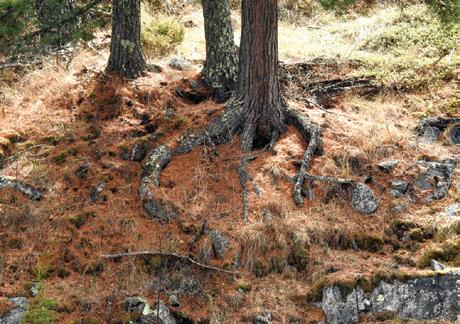
3 minute read
Succession from bare rock to forest
BY DAVE SCHWARTZ
It’s a bit of a stretch to look at the rock outcroppings in our area and visualize beautiful, mature forests in their place. However, that’s just normal if nature gets its way without interruption. As the glaciers receded from our area about 10,000 years ago, they left many signs of their passage. Among those were many areas scraped right down to bare rock. While bare rock is still evident, most areas are now covered by forest. The process by which the landscape progresses from bare rock to forest is an example of primary succession.
Advertisement
Lichens are the first plants (pioneers) to colonize the harsh, soilless, often arid environment of bare rock. The hardiest of all plants, lichens derive their subsistence from thin air. They consist of algae and fungi in a symbiotic relationship in which the algae produce carbohydrates by photosynthesis and the fungi provide shelter, shade and water absorption for the algae. Together they release carbon dioxide, which mixes with rainwater to form carbonic acid. The weak acid begins breaking the rock into small grit-sized pieces which wash down into depressions or cracks in the rock along with dust, decayed organic material and tiny rock fragments produced by erosion to form the first soil. The rate at which this happens is dependent on climate and occurs more rapidly in warm, moist conditions.
Once the lichens have built sufficient soil, mosses begin to grow and eventually out-compete and replace the lichens starting in the cracks, depressions and crevices in the rock and spreading out from there. Some mosses have the ability to establish themselves directly on certain types of rock but normally rely on lichens to improve conditions before they take hold. Mosses grow faster than lichens and the soil building process accelerates. Tiny organisms, such as insects move in, add their remains to soil when they die and decay.
Eventually, there is sufficient soil to support grasses and other herbaceous plants. Lichen-covered rock is interspersed with patches of various, more advanced, stages of vegetation. As soil continues to accumulate and hold more moisture, shrubs gain a foothold. After the establishment of the shrub stage and more soil formation, the environment becomes more humid and trees start to colonize the site. As the trees grow larger, the forest floor becomes more shaded. The plants beneath the canopy of trees are gradually replaced by more shade-tolerant species.
In the Lake of the Woods area boreal forest the most common tree species on former bare rock sites are balsam and primarily jack pine. White pine is also common in our southern regions and extends northward along the Lake of the Woods and Winnipeg River due to the climatic influence of large water bodies.

Mighty white pines thrive on former bare rock sites by spreading their roots through the meagre soil and into cracks and crevices in the rock. A forest fire has destroyed most or all of the organic soil around the charred tree root and set succession back to an earlier stage.

A forest fire has destroyed most or all of the organic soil around the charred tree root and set succession back to an earlier stage.
When jack pine is the dominant species, the forest depends on fire to regenerate as its cones only open to release their seeds at high temperatures. Jack pine trees are shade intolerant so the understory in a jack pine forest will have shade tolerant species, usually balsam fir. As the jack pines age and die, the balsam fir takes over. Balsam fir forest is prone to damage by spruce budworm, creating ideal conditions for forest fires. Fire opens the dormant jack pinecones putting the site on its way to a renewed jack pine forest. If fire strikes the jack pine forest, the forest will renew itself with the released seed, provided the trees are old enough to have cones.
Fire and logging are the two main factors which set back forests in this area. On average, without fire suppression, any given area of forest burns about every 70 years. When forests on former bare rock are destroyed by an extremely hot fire, it may completely destroy the plant community and burn all the organic soil. The process of primary succession starts over with lichens recolonizing the rock. If the fire is less intense, the plant community may be temporarily destroyed but the soil remains. When this happens, the plant community will re-establish itself at a later development stage and a new forest will be established relatively quickly in a process called secondary succession. Similarly, when an area is logged, the soil remains behind and secondary succession will begin if the area is not replanted with a particular commercially desired species.
Nature has also left areas of clay soil, sand from ancient beaches, gravel deposits from ancient beaches and riverbeds, deposits of glacial till and deep organic peat soil.
Since soil type determines the composition of forest in any given climate, it’s interesting to wander in our forests and ponder how they came to be and what lies underneath.










